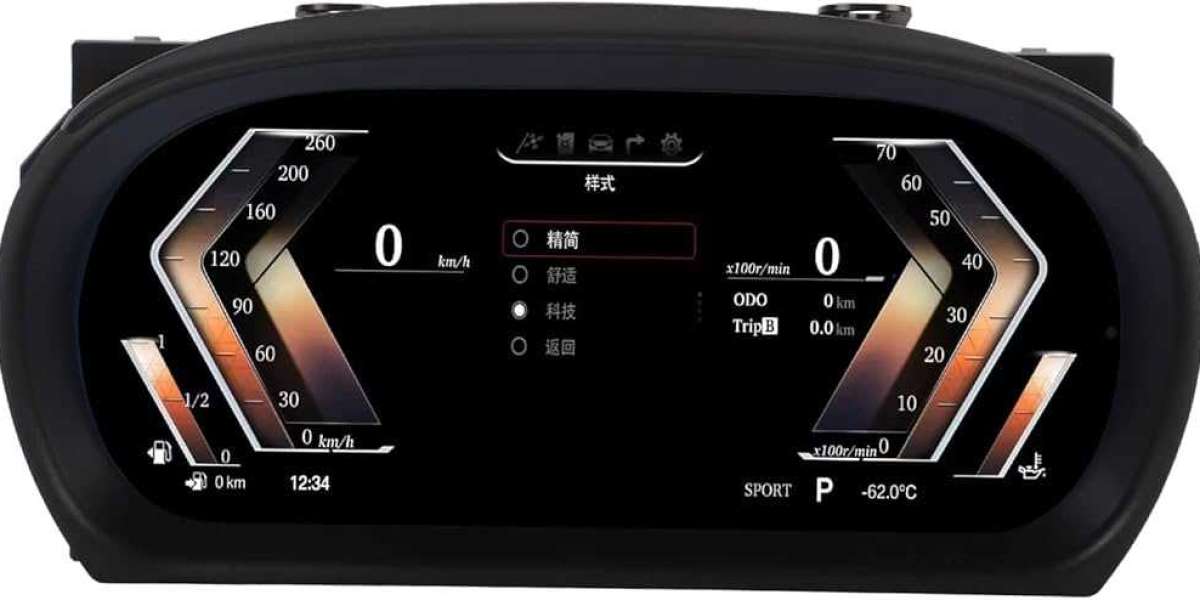An automotive digital instrument cluster is a modern dashboard display that replaces traditional analog gauges with digital screens. These clusters provide drivers with vital information about the vehicle's performance, navigation, and entertainment systems in a customizable and user-friendly format. As vehicles become increasingly sophisticated, digital instrument clusters are becoming standard features, enhancing the driving experience and improving safety. This article examines the importance of digital instrument clusters, the technologies involved, their applications, and the benefits they offer.
Importance of Automotive Digital Instrument Clusters
Digital instrument clusters are essential for several reasons:
Enhanced Visibility: Digital displays provide clearer and more vibrant visuals compared to traditional analog gauges, improving readability under various lighting conditions.
Customizability: Drivers can often customize the layout and information displayed on digital clusters, allowing for a more personalized driving experience.
Integration of Advanced Features: Digital clusters can seamlessly integrate advanced features such as navigation, driver assistance alerts, and vehicle diagnostics, providing comprehensive information at a glance.
Improved Safety: By consolidating critical information into a single display, digital instrument clusters help reduce distractions and allow drivers to focus on the road.
Technologies Used in Automotive Digital Instrument Clusters
Several technologies are employed in automotive digital instrument clusters:
LCD and OLED Displays: Liquid Crystal Display (LCD) and Organic Light Emitting Diode (OLED) technologies are commonly used for their high resolution, color vibrancy, and energy efficiency.
Microcontrollers: These are the central processing units that manage the data displayed on the instrument cluster, processing inputs from various vehicle systems.
Graphics Processing Units (GPUs): GPUs enhance the visual quality of the display, enabling smooth animations and transitions for a more engaging user experience.
Touchscreen Interfaces: Some digital clusters feature touchscreen capabilities, allowing drivers to interact with the display directly for navigation and settings adjustments.
Connectivity Features: Many digital instrument clusters are equipped with connectivity options such as Bluetooth and Wi-Fi, enabling integration with smartphones and other devices.
Applications of Automotive Digital Instrument Clusters
Digital instrument clusters are used in various applications within vehicles:
Speed and Performance Monitoring: Displaying real-time speed, RPM, fuel levels, and engine temperature, digital clusters provide essential performance metrics.
Navigation: Integrated GPS navigation systems can display maps, directions, and traffic information directly on the instrument cluster, reducing the need for separate navigation devices.
Driver Assistance Features: Digital clusters can show alerts for lane departure warnings, adaptive cruise control, and collision avoidance systems, enhancing driver awareness.
Vehicle Diagnostics: Real-time diagnostics provide information on vehicle health, including tire pressure, battery status, and maintenance reminders.
Entertainment Integration: Digital clusters can display information from multimedia systems, including music playback, phone calls, and notifications, allowing drivers to stay connected without distraction.
Benefits of Automotive Digital Instrument Clusters
The implementation of digital instrument clusters offers numerous advantages:
Improved User Experience: Customizable displays enhance the driving experience by allowing drivers to prioritize the information that matters most to them.
Increased Safety: By consolidating information into a single view, digital clusters reduce the need for drivers to look away from the road, minimizing distractions.
Future-Proofing: Digital clusters can be updated with new software features and functionalities, ensuring that vehicles remain current with technological advancements.
Enhanced Aesthetics: Digital displays can be designed with visually appealing graphics and animations, contributing to the overall interior design of the vehicle.
Data Analysis: Digital clusters can collect and analyze driving data, providing insights that can help improve driving habits and vehicle performance.
Challenges in Automotive Digital Instrument Clusters
Despite the benefits, several challenges exist in the implementation of digital instrument clusters:
Cost Considerations: The initial cost of implementing digital clusters can be higher than traditional analog gauges, potentially impacting vehicle pricing.
Technical Issues: Digital displays can be susceptible to technical problems, such as screen failures or software glitches, which may require repairs or replacements.
Driver Distraction: While digital clusters aim to reduce distractions, complex interfaces or excessive information can overwhelm drivers, leading to potential safety risks.
Compatibility Issues: Integrating digital clusters with existing vehicle systems can pose challenges, especially in older vehicle models.
User Adaptability: Some drivers may find it difficult to adapt to digital displays, particularly those accustomed to traditional analog gauges.
Future Prospects for Automotive Digital Instrument Clusters
The future of automotive digital instrument clusters looks promising, with several trends expected to shape the industry:
Augmented Reality (AR): Future clusters may incorporate AR technology to overlay information directly onto the driver's view of the road, enhancing situational awareness.
Artificial Intelligence (AI): AI integration will enable more personalized experiences, with clusters adapting to individual driver preferences and habits.
Increased Connectivity: Enhanced connectivity features will allow for better integration with smart devices, providing seamless access to apps and services.
Advanced Customization: Future clusters will likely offer even greater customization options, allowing drivers to design their interfaces according to personal preferences.
Sustainability Initiatives: As the automotive industry focuses on sustainability, digital clusters may use eco-friendly materials and energy-efficient technologies.
Automotive digital instrument clusters are transforming the way drivers interact with their vehicles, providing essential information in a user-friendly and customizable format. By leveraging advanced technologies and integrating multiple functions into a single display, digital clusters enhance safety, improve the driving experience, and pave the way for future innovations in vehicle design. As the automotive industry continues to evolve, digital instrument clusters will play a crucial role in shaping the future of driving.







